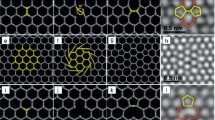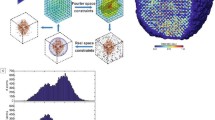Abstract
Two-dimensional (2D) materials are among the most studied ones nowadays, because of their unique properties. They are made of single- or few-atom-thick layers whose variation in the stacking sequence may result in a variety of crystallographic structures, whether they are assembled by van der Waals forces or covalently bonded. Although identifying both the number of layers and the stacking sequence is of an utmost importance because of the driving role these parameters have on the properties, there is currently no technique available to do so. We demonstrate here that combining low energy (1–10 keV) electron diffraction with the usual high energy (> 50 keV) electron diffraction on the same 2D object is able to fill the gap. We illustrate this by taking the examples of a variety of 2D materials, built from either a single type of atom with low Z-number such as graphene (C), or two types of atoms with low Z-number such as diamane (C2H), or two types of atoms with high Z-number such as MoS2. Meanwhile, we propose a simplified method for comparing calculated patterns to experimental ones, and discuss the limitation of the technique.



Similar content being viewed by others
Data availability
Most of the data are provided either in the main article, or a Supplementary Information. Any data missing or materials are available upon request to the corresponding author.
Code availability
Code can be made available upon request to the corresponding author.
References
S. Horiuchi, T. Gotou, M. Fujiwara, R. Sotoaka, M. Hirata, K. Kimoto, T. Asaka, T. Yokosawa, Y. Matsui, K. Watanabe, M. Sekita, Jpn. J. Appl. Phys. 42, L1073 (2003)
J.C. Meyer, A.K. Geim, M.I. Katsnelson, K.S. Novoselov, T.J. Booth, S. Roth, Nature 446, 60 (2007)
J.C. Meyer, A.K. Geim, M.I. Katsnelson, K.S. Novoselov, D. Obergfell, S. Roth, C. Girit, A. Zettl, Sol. State Comm. 143, 101 (2007)
Y. Hernandez, V. Nicolosi, M. Lotya, F. M. Blighe, Z. Sun, S. De, I. T. McGovern, B. Holland, M. Byrne, Y. Gun’ko, J. Boland, P. Niraj, G. Duesberg, S. Krishnamurti, R. Goodhue, J. Hutchison, V. Scardaci, A. C. Ferrari, J. N. Coleman, Nature Nanotechnol. 3, 563 (2008)
Y.J. Suh, S.Y. Park, M.J. Kim, Microsc. Microanal. 15, 1168 (2009)
N. Behabtu, J.R. Lomeda, M.J. Green, A.L. Higginbotham, A. Sinitskii, D.V. Kosynkin, D. Tsentalovich, A.N.G. Parra-Vasquez, J. Schmidt, E. Kesselman, Y. Cohen, Y. Talmon, J.M. Tour, M. Pasquali, Nature Nanotechnol. 5, 406 (2010)
J. Ping, M.S. Fuhrer, Nano Lett. 12, 4635 (2012)
B. Shevitski, M. Mecklenburg, W.A. Hubbard, E.R. White, B. Dawson, M.S. Lodge, M. Ishigami, B.C. Regan, Phys. Rev. B 87, 045417 (2013)
T. Latychevskaia, S.-K. Son, Y. Yang, D. Chancellor, M. Brown, S. Ozdemir, I. Madan, G. Berruto, F. Carbone, A. Mishchenko, K.S. Novoselov, Front. Phys. 14, 13608 (2019)
P.V. Bakharev, M. Huang, M. Saxena, S.W. Lee, S.H. Joo, S.O. Park, J. Dong, D.C. Camacho-Mojica, S. Jin, Y. Kwon, M. Biswal, F. Ding, S.K. Kwak, Z. Lee, R.S. Ruoff, Nature Nanotechnol. 15, 59 (2020)
P. Deb, M. C. Cao, Y. Han, M. E. Holtz, S. Xie, J. Park, R. Hovdena, D. A. Muller, Ultramicrosc. 215, 113019 (2020)
L.A. Chernozatonskii, P.B. Sorokin, A. Kvashnin, D.G. Kvashnin, J. Exp. Theor. Phys. Lett. 90, 134 (2009)
D.C. Elias, R.R. Nair, M.G. Mohiuddin, S.V. Morozov, P. Blake, M.P. Halsall, A.C. Ferrari, D.W. Boukhvalov, M.I. Katsnelson, A.K. Geim, K.S. Novoselov, Science 323, 610 (2009)
F. Piazza, K. Gough, M. Monthioux, P. Puech, I. Gerber, R. Wiens, G. Paredes, C. Ozoria, Carbon 145, 10 (2019)
F. Piazza, M. Monthioux, P. Puech, I. Gerber, Carbon 156, 234 (2020)
F. Piazza, K. Cruz, M. Monthioux, P. Puech, I. Gerber, Carbon 169, 129 (2020)
Z. Wang, S. Ning, T. Fujita, A. Hirata, M. Chen, ACS Nano 10, 10308 (2016)
B.E. Smith, D.E. Luzzi, J. Appl. Phys. 90, 3509 (2001)
F. Piazza, M. Monthioux, P. Puech, I.C. Gerber, K. Gough, J. Carbon Res. 7, 9 (2021)
V.S. Neverov, SoftwareX. 6, 63 (2017)
D. Sen, K.S. Novoselov, P.M. Reis, M.J. Buelher, Small 6, 1108 (2010)
A. Dato, V. Radmilovic, Z. Lee, J. Phillips, M. Frenklach, Nano Lett. 8, 2012 (2008)
K. Kim, Z. Lee, W. Regan, C. Kisielowski, M.F. Crommie, A. Zettl, ACS Nano 5, 2142 (2011)
Acknowledgements
The authors thank R. Ruoff for stimulating discussions.
Funding
This work is funded by the EUR grant NanoX n° ANR-17-EURE-0009 in the framework of the French "Programme des Investissements d’Avenir" and by the Ministry of Higher Education, Science and Technology of the Dominican Republic (2016–2017 and 2018 FONDOCyT programs).
Author information
Authors and Affiliations
Contributions
P.P. is at the origin of the methodology principle and performed the calculations. I.G. contributed to the calculations and supplied information on MoS2. F.P. provided the 2LG materials and carried out the low-voltage electron diffraction work. M.M. wrote most of the paper. All the authors contributed to discussing the results and the manuscript versions.
Corresponding authors
Ethics declarations
Conflict of interest
The authors declared that there is no conflict of interest.
Additional information
Publisher's Note
Springer Nature remains neutral with regard to jurisdictional claims in published maps and institutional affiliations.
Supplementary Information
Below is the link to the electronic supplementary material.
339_2021_4568_MOESM1_ESM.docx
Supporting Information are provided, reminding the basics on the possible stacking sequences in graphene, giving details on the methodology proposed to calculate spot intensities in the diffraction patterns, and providing further data. (DOCX 939 kb)
Rights and permissions
About this article
Cite this article
Puech, P., Gerber, I.C., Piazza, F. et al. Combining low and high electron energy diffractions as a powerful tool for studying 2D materials. Appl. Phys. A 127, 485 (2021). https://doi.org/10.1007/s00339-021-04568-9
Received:
Accepted:
Published:
DOI: https://doi.org/10.1007/s00339-021-04568-9




